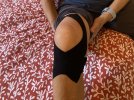- Time of past OR future Camino
- .
I recently returned from the camino. I’ve been getting increasingly sore and crackly knees over the last 5 years, but now it’s becoming an issue. I don’t tend to experience much discomfort while walking, except the usual, on long steep downhills – or worse, whole days on the flat. But at night I lie awake in my bunk trying to deal with the pain. It used to recede around midnight, which was OK, but on this last trip it was often still present until 3-4 in the morning. Sometimes I’d take a little Ibuprofen and other times not, as there didn’t seem to be much difference. X-rays on my return (for some camino-sustained fractures, unrelated) show arthritic wear to both knees, so I can no longer ignore that it’s really happening.
What I’m interested in hearing about and exploring with other forum members is how their knee journeys are working out. I can see that my knees are only going in one direction and that ultimately I will probably need to access that Developed World luxury of knee replacement surgery (if I can find the money…). But what happens between now and then? Do many people go down the Synvise/Orthovise injection route first, or is that enough for some to stabilise their birth knees’ usefulness and never need the replacement surgery?
I’m particularly interested in hearing from people who felt their knee pain was becoming a significant issue 5-20 years ago, and what has happened since.
I’m keen to find out whether there are any actions I can take now to prolong the usefulness of my birth knees in my day to day activities, like Glucosamine supplements. I’m already doing a range of exercises.
Or maybe there are some of you that just revised your walking expectations downwards and now do slower, shorter stages and appear to have stabilised at that level?
I’m hoping we can steer clear of repeating all the usual strategies people take while actually walking, as I think those have been covered extensively already, whether it’s using walking/pacer poles, having impact reducing shoes like Altras or Hokas, employing kinesiology tape or knee braces or compression sleeves etc etc. But if you feel these or others are an integral part of your successful stabilising strategy then do say so.
FYI, before posting I did a search on knee journeys on this forum. Here are a couple of related threads, mainly about surgery
https://www.caminodesantiago.me/community/threads/walking-after-knee-replacements.65173/
Cheers, tom
What I’m interested in hearing about and exploring with other forum members is how their knee journeys are working out. I can see that my knees are only going in one direction and that ultimately I will probably need to access that Developed World luxury of knee replacement surgery (if I can find the money…). But what happens between now and then? Do many people go down the Synvise/Orthovise injection route first, or is that enough for some to stabilise their birth knees’ usefulness and never need the replacement surgery?
I’m particularly interested in hearing from people who felt their knee pain was becoming a significant issue 5-20 years ago, and what has happened since.
I’m keen to find out whether there are any actions I can take now to prolong the usefulness of my birth knees in my day to day activities, like Glucosamine supplements. I’m already doing a range of exercises.
Or maybe there are some of you that just revised your walking expectations downwards and now do slower, shorter stages and appear to have stabilised at that level?
I’m hoping we can steer clear of repeating all the usual strategies people take while actually walking, as I think those have been covered extensively already, whether it’s using walking/pacer poles, having impact reducing shoes like Altras or Hokas, employing kinesiology tape or knee braces or compression sleeves etc etc. But if you feel these or others are an integral part of your successful stabilising strategy then do say so.
FYI, before posting I did a search on knee journeys on this forum. Here are a couple of related threads, mainly about surgery
https://www.caminodesantiago.me/community/threads/walking-after-knee-replacements.65173/
Cheers, tom

























